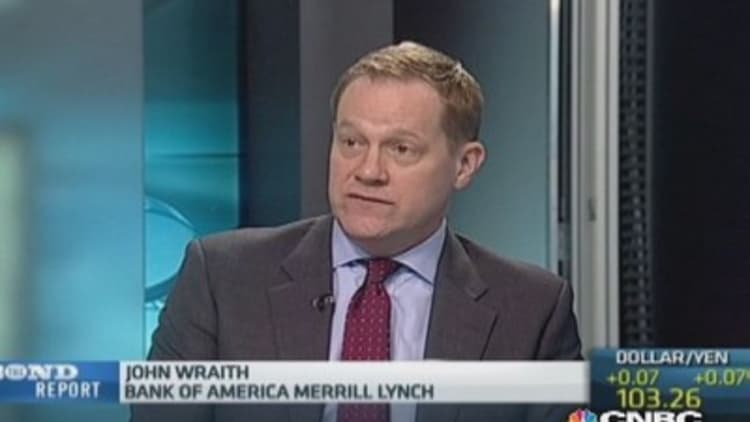All good things must come to an end.
Unfortunately, for anyone with a bond allocation, that includes rock-bottom interest rates.
Rates continue to hover at historic lows, but it's only a matter of time before they rise. It remains to be seen when they'll rise and by how much, but if you haven't already reevaluated your portfolio—specifically, your bond allocation—to hedge against higher interest rates, you'd better start, financial experts say.
There are various strategies investors can use to help offset the impact of rising rates, but in order to avoid taking on substantially more risk in your portfolio, your best bet is to implement a combination of strategies.
"The worst thing you can do is think there's one single panacea to the problem," said David Lafferty, chief market strategist with Natixis Global Asset Management.
"There are lots of things you can do, but every one thing that helps you manage interest-rate risk by itself has a downside risk," he added. "There's no free lunch when it comes to reducing exposure to higher rates, so you want to take a diversified approach."
Read MoreRetirees brace for rising rates
Lafferty, who believes rates could hit the mid- to high 3 percent range by the end of this year or early next, said that now is the time to be making portfolio adjustments. "Interest rates are notoriously difficult to predict," he said. "They can move very quickly, and it's difficult to react to rates, so you want to be out in front of it."
Scott Cramer, president of financial advisory firm Cramer & Rauchegger, said reducing exposure to long-term bonds should be first on investors' priority list.
"If you are going to use bonds, stay in short- or medium-term bonds," he said, as they will be less sensitive to rising rates.

Bond prices and interest rates have an inverse relationship: As interest rates rise, bond prices fall. Longer maturity bonds are more vulnerable to rising rates because they are locked into rates for a longer period of time.
However, Cramer added that although some investors view shorter-duration bonds as a quick and easy solution to combat rising rates, the downside is that the shorter the duration is, the lower the yield will be. That means less income potential.
Another strategy in times of rising rates is to invest in floating-rate securities—such as bank loans and Treasury Inflation-Protected Securities—which have adjustable, rather than fixed, interest rates, making them less sensitive to rate increases.
Read MoreRising rates to sting consumers
Jeff Bakalar, co-portfolio manager of the ING Floating Rate Fund and the ING Senior Loan Fund, said bank loans are "one of few asset classes that can provide downside capital protection and upside participation in rising rates."
Investors have clearly seen the merit in this strategy. To that point, March 12 marked the 91st consecutive week that bank-loan mutual funds and ETFs have seen inflows of retail cash, according to mutual fund research firm Lipper.
But again, you can't discount the risks.
For one thing, the sheer growth of the asset class makes it potentially vulnerable to a selloff. Additionally, bank loans are a below-investment-grade asset class, like high-yield bonds, and they're mark-to-market (the market determines the value), so you're not protected from losing money.
"Investors need to understand that it's not risk-free," Bakalar said. "You're getting excess yield because you're taking below-grade risk."
He added that investors who are considering bank loan funds or ETFs need to understand exactly what they're getting before investing, as these funds can allocate as much as 20 percent to other asset classes.
Read MoreKnow your bonds vs. bond funds
While TIPS can also be used as a floating-rate investment, their rates are pegged to the consumer price index (CPI), so they are more effective when rising rates are being driven by inflation.
Lafferty of Natixis added that another way to combat rising rates is to invest in parts of the bond market that aren't as interest-rate sensitive, such as securities that fall on the lower end of investment grade, including high-yield bonds and convertible bonds.
"They come with the added advantage that you get a bit more income," he said. "The yield advantage of those securities offers a bit of a cushion when you have principle losses."
However, Lafferty added that with those securities, investors are trading credit risk for interest-rate risk. "While it's a good [strategy], it's not a panacea, because you're taking on more credit risk," he said.
Read MoreAdvisors say keep bonds but stay alert
Investors may also opt to shift some assets out of fixed income and into equities—particularly dividend-paying stocks, real estate investment trusts or preferred equity, which are less interest-rate sensitive than high-quality bonds and have an income component—or other non-correlated asset classes, such as commodities, hedge funds and private equity.
While changing your fixed-income allocation could provide a buffer against rising rates, it's not something to do lightly. These investments could pose higher volatility and risk, and it could fundamentally change your overall asset-allocation strategy.




